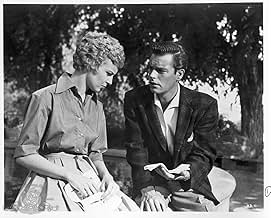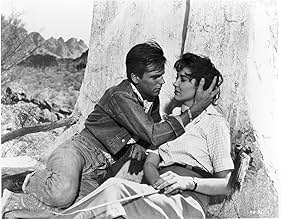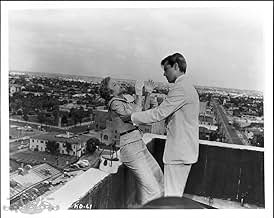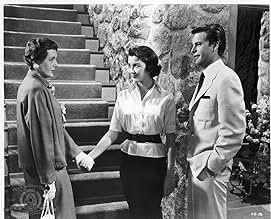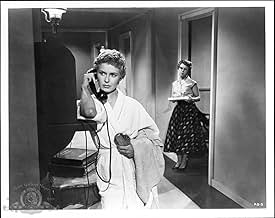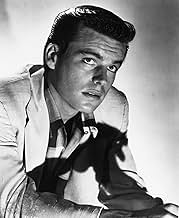CALIFICACIÓN DE IMDb
6.7/10
4.7 k
TU CALIFICACIÓN
Un estudiante universitario despiadado recurre al asesinato en un intento de casarse con una heredera.Un estudiante universitario despiadado recurre al asesinato en un intento de casarse con una heredera.Un estudiante universitario despiadado recurre al asesinato en un intento de casarse con una heredera.
- Dirección
- Guionistas
- Elenco
Albert Cavens
- Restaurant Patron
- (sin créditos)
Robert Ivers
- Student at Murder Scene
- (sin créditos)
Mickey Martin
- Student
- (sin créditos)
Joe McGuinn
- Chemistry Professor
- (sin créditos)
Edwin Rochelle
- Restaurant Patron
- (sin créditos)
Jack Stoney
- Policeman
- (sin créditos)
- Dirección
- Guionistas
- Todo el elenco y el equipo
- Producción, taquilla y más en IMDbPro
Opiniones destacadas
I read Ira Levin's book when I was young, sometime in the 1960s, and loved it. It's very chilling, and I think as good as Rosemary's Baby. Better than the Stepford Wives and Boys from Brazil.
This film is a quite bizarre mixture of the chilling and the comical. Someone above has mentioned the scene where Bud and Dorie are having an intense conversation when suddenly a middle-aged woman in a completely see-through blouse with a great big bra underneath walks between them and halts the conversation; she has nothing whatsoever to do with the plot, and when it happened I literally burst out laughing at the incongruousness of it. I also laughed at Jeffrey Hunter's ridiculous attempts to manipulate heavy Clark Kent spectacles and an unlit pipe in a vain attempt to appear mature.
The good points about the film are the plot, which is gripping even though it's been shortened markedly from the book, and some of the acting, particularly Robert Wagner and Joanne Woodward -- and I also enjoyed George Macready as the father of Dorie and Ellen.
The fact is that I was consistently interested or amused or gripped by something or other for the whole of the film. You can't really ask for much more from a film.
This film is a quite bizarre mixture of the chilling and the comical. Someone above has mentioned the scene where Bud and Dorie are having an intense conversation when suddenly a middle-aged woman in a completely see-through blouse with a great big bra underneath walks between them and halts the conversation; she has nothing whatsoever to do with the plot, and when it happened I literally burst out laughing at the incongruousness of it. I also laughed at Jeffrey Hunter's ridiculous attempts to manipulate heavy Clark Kent spectacles and an unlit pipe in a vain attempt to appear mature.
The good points about the film are the plot, which is gripping even though it's been shortened markedly from the book, and some of the acting, particularly Robert Wagner and Joanne Woodward -- and I also enjoyed George Macready as the father of Dorie and Ellen.
The fact is that I was consistently interested or amused or gripped by something or other for the whole of the film. You can't really ask for much more from a film.
Set against the backdrop of the shiny 1950s, "A Kiss Before Dying" is a taunt thriller that can arguably be voted the predecessor of many modern thrillers.
When the film starts, it looks like a glamorous, teenybopper flick. The opening song compliments this heavily, as does the numerous logos and neon colours used in the opening credits. Thinking back on it now, I find it to be a very unusual, brilliant style of film-making that isn't seen very often. It tricks the viewer into something it is not. It is not a 1950s college comedy, but a relentless thriller with lots of unexpected twists and turns. I thought this movie was going to be tame, being a 1950s film and all, but I was pleasantly surprised in how raw the plot was in some places.
A young Robert Wagner portrays Bud Corliss, a darkly handsome college student with an obsessive taste for riches and fine dining. Bud is a trouble 25 year-old man who still lives at home with his aging widowed mother (Mary Astor). He feels unfulfilled in his life and a little uncertain about his future. Dorothy Kingship (Joanne Woodward), a girl with whom he is having a secret relationship with, may be the only glimmer of hope that will lift him up out of his bland, disappointing life. Dorothy's father is incredibly wealthy, and Bud knows this. However, Dorie falls pregnant and Bud is threatened with disinheritance and the inevitable prospect of working as a gas station attendant in order to pay the bills for his wife a baby. This is where the film really takes off and we get to see how dark, desperate and evil Bud really is.
Bud devises a plan: stage his girlfriends suicide. The plan seems simple enough and actually works in Bud's favour. He is free of Dorie and the prospect of disinheritance, and is now able to court Dorie's older sister, Ellen (Virginia Leith), who is totally oblivious of the fact that Bud is Dorie's old flame (and murderer). Enter rookie detective Gordon Grant (Jeffrey Hunter), an intelligent young man who questions the circumstances surrounding Dorie's death, as well as the integrity of Ellen's new lover, Bud. He just has to put the gruesome pieces together to solve the complex puzzle of deceit and murder.
I recommend this movie to fans of the thriller genre, as well as those who want to take a trip down memory lane. Great film with top performance by all. Kudos to Jeffrey Hunter.
When the film starts, it looks like a glamorous, teenybopper flick. The opening song compliments this heavily, as does the numerous logos and neon colours used in the opening credits. Thinking back on it now, I find it to be a very unusual, brilliant style of film-making that isn't seen very often. It tricks the viewer into something it is not. It is not a 1950s college comedy, but a relentless thriller with lots of unexpected twists and turns. I thought this movie was going to be tame, being a 1950s film and all, but I was pleasantly surprised in how raw the plot was in some places.
A young Robert Wagner portrays Bud Corliss, a darkly handsome college student with an obsessive taste for riches and fine dining. Bud is a trouble 25 year-old man who still lives at home with his aging widowed mother (Mary Astor). He feels unfulfilled in his life and a little uncertain about his future. Dorothy Kingship (Joanne Woodward), a girl with whom he is having a secret relationship with, may be the only glimmer of hope that will lift him up out of his bland, disappointing life. Dorothy's father is incredibly wealthy, and Bud knows this. However, Dorie falls pregnant and Bud is threatened with disinheritance and the inevitable prospect of working as a gas station attendant in order to pay the bills for his wife a baby. This is where the film really takes off and we get to see how dark, desperate and evil Bud really is.
Bud devises a plan: stage his girlfriends suicide. The plan seems simple enough and actually works in Bud's favour. He is free of Dorie and the prospect of disinheritance, and is now able to court Dorie's older sister, Ellen (Virginia Leith), who is totally oblivious of the fact that Bud is Dorie's old flame (and murderer). Enter rookie detective Gordon Grant (Jeffrey Hunter), an intelligent young man who questions the circumstances surrounding Dorie's death, as well as the integrity of Ellen's new lover, Bud. He just has to put the gruesome pieces together to solve the complex puzzle of deceit and murder.
I recommend this movie to fans of the thriller genre, as well as those who want to take a trip down memory lane. Great film with top performance by all. Kudos to Jeffrey Hunter.
This Cinemascope Technicolor murder drama from 1955 is a great looking film with perfect 50s visuals to carry it well in 2008. In retrospect, I can see the source for both PEEPING TOM and PSYCHO both in 1960 offering the 'shocking' image of a square cut handsome young man as a cruel killer. Of course that idea alone is really a flip on MONSIEUR VERDOUX with Chaplin as the ageing dandy/ dapper killer and even the comedy ARSENIC AND OLD LACE again with the least suspecting type as killers. This version of KISS now-days is reflected in MR RIPLEY too. While it is not up the caliber of that film either, these films all form a group of murder mysteries depicting unassuming types revealed to be murderers. A KISS BEFORE DYING has the very handsome Robert Wagner and equally good looking Jeffrey Hunter pitched front and center for what must have been wild female audience reaction. One scene late in the film set in the desert features Wagner in the tightest jeans imaginable looking like a gay denim version of James Dean. It is all a bit silly in its storyline (university campus killer and rich girl family dramas) but visually it is a real 50s treat. Remade clumsily as a Matt Dillon thriller in 1991, this really is the better version completely because of the great looking cast (incl Joanne Woodward and Mary Astor) and the immensely enjoyable Cinemascope 50s set design and art direction.
According to Alicia Malone, the beautiful and intelligent host at tcm, "A Kiss Before Dying" is considered by Joanne Woodward to be not only her worst picture but the worst picture ever made by Hollywood. Oh c'mon, Joanne, considering some of the turkeys that I have seen with you and your late husband, Paul Newman, you can't possibly be serious. Don't get me wrong. Everyone is entitled to a living, and it's nice work if you can get it. At any rate, considering that Dore is supposed to be a bit of a whining nebbish, Joanne plays the part quite well.
I couldn't help from comparing this story, originating from Ira Levin's novel, to that of Theodore Dreiser's "An American Tragedy" which was adapted to the silver screen as "A Place in the Sun". While Levin's and Dreiser's stories both center on the very determined ambitions of two young men from very modest, if not impoverished, backgrounds, the big difference is that George Eastman (Montgomery Clift) in "Place in the Sun" does not deliberately kill the woman he impregnates. He only WANTS to kill her in the worst way and then does nothing to help her when she, herself, manages to overturn their rowboat on Loon Lake. This significantly distinguishes Eastman from Bud Corliss (Robert Wagner), who, to me, is far less sympathetic and far more depraved than George. The scenes at the closed marriage license offices in both films are also very similar.
The entire cast is excellent, and I would argue that this is among Mr. Wagner's best roles as an unlikely psychopathic murderer. Noteworthy is his brief scene with Mary Astor when he scolds her, his mother, for her wardrobe choice moments before he introduces her to his wealthy girlfriend's family. This one scene defines his character and gives us an important glimpse of at least some of the circumstances behind his motivation. Are the short haircuts of both Mom and Dore a mere coincidence, or is there much more lurking behind that similarity? Mary Astor, an outstanding actor, has always contributed greatly to all of the movies in which I have seen her, including "Act of Violence", "Dodsworth", and "The Maltese Falcon", only a few that immediately come to mind. George Macready, including his distinctively resonant voice, is another seasoned professional whose appearance is a very welcome bonus here. I thought that Virginia Lieth acts very decently, and she looks beautiful, so I don't know why I have never seen her in any other film.
The technicolor photography of cinematographer Lucien Ballard on location in and around Tucson, Arizona, including the campus of the University of Arizona, is exceptional. There is a noticeable crispness to it as it captures the unique architecture and natural surroundings of 1956 Tucson, days that only survive as they are archived by films such as this. Note the copper colored Thunderbird that Dore Kingship drives as well as the corded telephone and the swimming pool ladders of the same color. Someone had a barrel of fun making this picture.
As is the case with any film, there are some peculiar instances, including the reluctance of Dwight Powell at least to attempt to fight for his life. And where is the truck driver at the end? I expected him to appear immediately at the scene instead of hiding in his cab until the police arrive. And does Bud actually push Ellen out of the path of danger, as I believe he does? Also, if Bud's service during the Korean War is a factor behind his behavior, this should have been developed more as it should have but wasn't in the case of George Loomis (Joseph Cotton) in "Niagara", another favorite of mine from the same era.
I couldn't help from comparing this story, originating from Ira Levin's novel, to that of Theodore Dreiser's "An American Tragedy" which was adapted to the silver screen as "A Place in the Sun". While Levin's and Dreiser's stories both center on the very determined ambitions of two young men from very modest, if not impoverished, backgrounds, the big difference is that George Eastman (Montgomery Clift) in "Place in the Sun" does not deliberately kill the woman he impregnates. He only WANTS to kill her in the worst way and then does nothing to help her when she, herself, manages to overturn their rowboat on Loon Lake. This significantly distinguishes Eastman from Bud Corliss (Robert Wagner), who, to me, is far less sympathetic and far more depraved than George. The scenes at the closed marriage license offices in both films are also very similar.
The entire cast is excellent, and I would argue that this is among Mr. Wagner's best roles as an unlikely psychopathic murderer. Noteworthy is his brief scene with Mary Astor when he scolds her, his mother, for her wardrobe choice moments before he introduces her to his wealthy girlfriend's family. This one scene defines his character and gives us an important glimpse of at least some of the circumstances behind his motivation. Are the short haircuts of both Mom and Dore a mere coincidence, or is there much more lurking behind that similarity? Mary Astor, an outstanding actor, has always contributed greatly to all of the movies in which I have seen her, including "Act of Violence", "Dodsworth", and "The Maltese Falcon", only a few that immediately come to mind. George Macready, including his distinctively resonant voice, is another seasoned professional whose appearance is a very welcome bonus here. I thought that Virginia Lieth acts very decently, and she looks beautiful, so I don't know why I have never seen her in any other film.
The technicolor photography of cinematographer Lucien Ballard on location in and around Tucson, Arizona, including the campus of the University of Arizona, is exceptional. There is a noticeable crispness to it as it captures the unique architecture and natural surroundings of 1956 Tucson, days that only survive as they are archived by films such as this. Note the copper colored Thunderbird that Dore Kingship drives as well as the corded telephone and the swimming pool ladders of the same color. Someone had a barrel of fun making this picture.
As is the case with any film, there are some peculiar instances, including the reluctance of Dwight Powell at least to attempt to fight for his life. And where is the truck driver at the end? I expected him to appear immediately at the scene instead of hiding in his cab until the police arrive. And does Bud actually push Ellen out of the path of danger, as I believe he does? Also, if Bud's service during the Korean War is a factor behind his behavior, this should have been developed more as it should have but wasn't in the case of George Loomis (Joseph Cotton) in "Niagara", another favorite of mine from the same era.
If you're looking for an adaptation of the Ira Levin book--this isn't it. Also the book would be impossible to film. That aside this is OK murder mystery-thriller. I was lucky enough to see it letter-boxed on TCM--it looks great! However a film dealing with a psycho and murders he commits does NOT need a theme song! Acting is OK--not good, not bad, just OK. The cast is attractive, the film is beautiful to look at and it's an interesting diversion for 1 1/2 hours. So, an OK thriller--nothing really inventive or different about it. At all costs, AVOID the terrible 1991 remake! That one is a TOTAL waste of time!
¿Sabías que…?
- TriviaThe producers had to fight the Production Code office, or what was left of it by this time, to get the word "pregnant" into the film. Even then, the word was deleted in some parts of the country by local censors. The novel was further bowdlerized by having no discussion in the film between Bud and Dorothy about the possibility of her having an abortion, and the pills Bud gives her are said by him to be vitamins and are in fact simply poison to kill her - whereas in the novel they are intended to induce a termination of pregnancy.
- ErroresNear the end, Gordon is riding to the mine in a Cadillac limousine that has air conditioning, as indicated by small air scoops on both sides behind the back doors. The next shots (after the accident) show a different Cadillac without them. Cars of this era with factory installed air conditioning had half of the system in the trunk, requiring outside air via those little air scoops.
- Citas
Bud Corliss: It's not right.
Dorothy Kingship: What?
Bud Corliss: For anyone to love somebody as much as I love you.
- ConexionesReferenced in Living Single: A Kiss Before Lying (1993)
Selecciones populares
Inicia sesión para calificar y agrega a la lista de videos para obtener recomendaciones personalizadas
Detalles
- Tiempo de ejecución
- 1h 34min(94 min)
- Color
- Relación de aspecto
- 2.35 : 1
Contribuir a esta página
Sugiere una edición o agrega el contenido que falta


